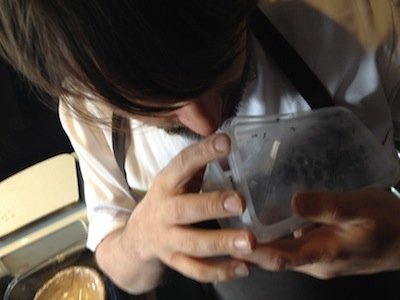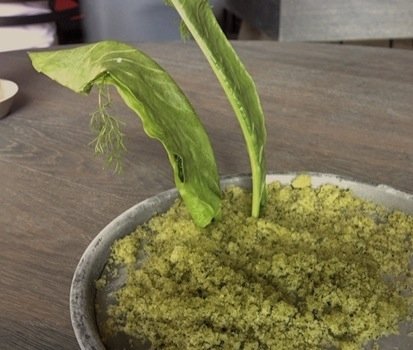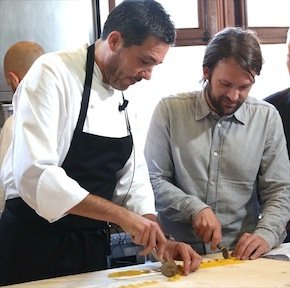see part one
Why betting on vegetables so much? «When I was a kid, in Macedonia, we ate meat on rare occasions. Killing a hen meant giving up an egg every morning. And killing a larger animal represented an even bigger sacrifice. This is why I grew up with vegetables, stewed beans and tomato salads. Not that at Noma people eat these things, but the basic idea is not very distant. For me there’s no doubt that the richness of the aromas in the vegetal world is much greater than what the meat of 2, 3 or 4 different animals can provide».

Redzepi smells his ants, trapped in a tupperware box in Copenhagen
. «This idea is followed by a series of ambitious long term projects. We’re already tracing a large map of the edible Danish biodiversity, defining all that it is possible to eat in our country. We’re analysing insects as part of the diet, with a project called the “deliciousness of entomophagy”. We received 500 thousand euros from a foundation for its development. A week later we published a study that confirms that the world will soon lament a desperate need for proteins. This is why we cannot ignore insects as a source of food».
«Ants were offered me for the first time years ago by Brazilian colleague and friend Alex Atala. In the Amazon Rainforest they are part of the daily diet. However, I still resisted tasting them. A little while later, in Mexico, I found myself in front of a basket of steamed ants’ eggs, more expensive than your truffle. I tasted them, chewed them, and discovered they had a very pleasant lemongrass flavour. Eureka: so even cold Denmark is rich of a flavour that we believed was confined to hotter and more exotic climates! That is when the experiments began. Today, starting from the ants we make salt, a paste and we put them in infusion in many different ways. We use them as spices, as a channel for a new aroma. To us, this represents a great new horizon».

Wood sorrel with cricket paste (inside the wood sorrel stalk). This is one of the typical uses of this insect at Noma
«Meanwhile, we’ve applied the truly Italian technique of
garum on the crickets caught in our countryside. We discovered that this species of insects and shrimps belong to the same family, both with reference to the chemical components and the essential aromas. So we took an old recipe for
garum and decided to make a blend of crickets. At first, it looked disgusting. We then added salt and let the mixture rest for 3-6 months. Starting from a sort of slush we obtained an extraordinary liquid which we use today as a seasoning to aromatise a large number of dishes. Adding some cricket sauce to wild spinach is like pressing the play button on a stereo. Of course I understand that were you to face a bowl of crickets or a dish with a nice and fat steak, you would always choose the second option. However, we cannot exclude anything. And think that perhaps insects don’t eat as much as animals, don’t need the same amount of water and they certainly fart less».
FERMENTATION. «With entomophagy, the Nordic Food Lab [in which young Sardinian Roberto Flore recently began to work] we’re also working extensively on fermenting processes. We all love bread, coffee, wine, beer, chocolate. All these, however, are the end result of a fermenting process, that is to say of the anaerobic action of bacteria. Even in this case, we only know a tiny part of all that a bacterium can do when in contact with raw materials. This science is still in its early stage and this is very exciting, stimulating».

Davide Palluda teaches Renè how to make a fresh pasta, piedmontese style
. Does the dining room or the kitchen count more in your restaurant? «50 and 50. The dining room is essential. For instance, in Copenhagen it often rains and clients are often wet when they arrive. Welcoming them with a familiar warmth is a must. I believe that the interpersonal connections between people are almost always more important than the pleasantness of the food we serve».
What do you think of Masterchef? «I haven’t got the faintest idea: I don’t even remember when I last watched television…».
And how about being considered the best chef in the world? «I really don’t believe Noma is the best restaurant in the world. I don’t even think a number one in the world can exist. I only know that since I was 15, I’ve been working from 75 to 90 hours per week. I am very happy to do what I do. Because it is a marathon leading to unexplored goals».
2. the end